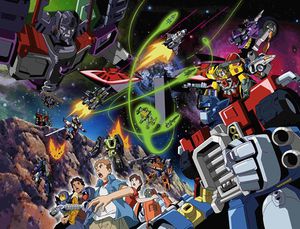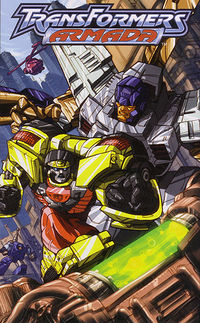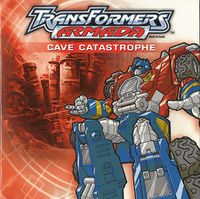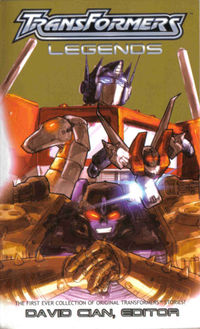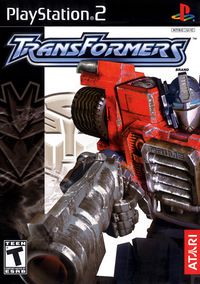Unicron Trilogy continuity family
From Transformers Wiki
The eponymous "Unicron Trilogy", consisting of the Armada, Energon, and Cybertron franchises, forms the basis for the entire Unicron Trilogy continuity family. The fourth-largest continuity family encompasses three cartoons, two comics, and multiple storybooks and video games; it is named for the central role Unicron plays in the overall story, since all three series revolve around him in some way—even Cybertron, where his destruction results in the creation of the series' primary threat, the universe-threatening black hole.
As the first true Japanese-American coproduction to come out of the Transformers franchise, the three television shows that constitute the bulk of this continuity were originally produced in Japan and later exported and dubbed to other countries for international release. Along with Robots in Disguise, the cartoons are remembered for their Japanese influences—each installment features plenty of mecha-inspired super modes and supernatural power boosts. Although Western Armada fiction like Dreamwave's comics played the premise straighter and hewed closer to Marvel's 1980s The Transformers comic in tone, many of the surface-level anime stylings remained. From a meta perspective, the Unicron Trilogy is also notable for introducing a third faction of diminutive, power-boosting Mini-Cons while reintroducing Primus—divine creator of the Transformer race—to the overarcing Transformers mythos.
Within the fictional Transformers multiverse, the TransTech classify every Unicron Trilogy continuity as a part of the "Aurex" universal cluster.
Contents |
Major continuities
As of 2024, we identify three major continuities in this family, many of which possess a number of notable sub-branches and micro-continuities. The lists below are not meant to be complete guides to every work in that continuity, but provide a quick overview of that continuity's most notable media.
Dreamwave Armada continuity
- Transformers: Armada (2002-2003)
- More than Meets the Eye: Transformers: Armada (2004)
- Transformers: Energon (2004)
Dreamwave Productions acquired the Transformers license in 2002, and launched an Armada tie-in comic alongside their "Generation One" storyline. Like many other Transformers tales, Armada begins on a war-torn Cybertron as Optimus Prime's Autobots battle Megatron's Decepticons—in this subset of realities, however, the war is fought not for energon or territory, but for control of the planet's Mini-Cons, a third faction of tiny, power-boosting Cybertronians. But when the Mini-Cons flee their planet aboard the starship Exodus, a freak accident strands half of the Mini-Cons on Earth and eventually brings them into contact with humanity. When the Autobots and Decepticons travel to Earth to continue their war, however, they make contact with three human children and discover that not all of the Mini-Cons want to ally themselves with the Autobots. Although the Armada comic is most notable for its frequent depiction of events from the Mini-Cons' point of view—unlike the anime, the comic depicted the Mini-Cons as normal Cybertronians with the ability to speak English—Armada's final arc abruptly pushes the ideological conflict between these three races to the side in favor of a climactic battle against Unicron and his five "Heralds", a quintet of dimension-hopping "Generation 1" Transformers led by Galvatron. Additionally, the More than Meets the Eye guidebook assigned personalities and profiles to basically every Armada character up to that point, even those who didn't appear in the comic.
In 2004, the comic rebranded itself as Transformers: Energon and followed the cartoon's example by skipping ten years into the future. Although Unicron's defeat led to a Decepticon surrender and a complete armistice, the Autobots now find themselves contending with Unicron's "Four Horsemen" who seek to revive their leader, while the mysterious Alpha Quintesson and his army of Terrorcons have their own designs for the remnants of the Decepticon army.
Ultimately, however, a combination of poor management, numerous financial troubles, and some extremely dubious business practices resulted in the company declaring bankruptcy in early 2005, though Hasbro had already decided to not renew their partnership with Dreamwave the year before.[1] As a result, the Energon comic abruptly ended midway through its run, although author Simon Furman has released several synopses of unpublished issues on his blog.[2]
Cartoons
- Transformers: Armada (2002-2003)
- Linkage (2003-2004)
- Transformers: Energon (2004-2005)
- Transformers: Cybertron (2005-2006)
The Transformers: Armada cartoon hit the airwaves in late 2002. Like Dreamwave's comic, the cartoon features the Autobots and Decepticons searching for Mini-Cons hidden across the planet Earth with the assistance of their human friends Rad, Carlos, and Alexis—though the Mini-Cons of this continuity lacked the ability to speak and communicated solely through electronic bleeps and bloops. Unlike Dreamwave's comic, however, the cartoon offered a distinctly sinister origin for these tiny Transformers: toward the end of the show's run, the heroes learned that the Mini-Cons were children of Unicron himself, artificial life-forms synthesized to deliberately stoke conflict between the two factions and sustain the planet-eater with their hatred.
Due to a hurried production cycle—most notably, the English dub was rushed to markets a whole six months before the Japanese version premiered—the Armada cartoon hit more than a few technical snafus along the way, including a number of blatant animation or dubbing errors. Unfortunately, the sequel cartoon, Transformers: Energon, only doubled down on many of the same production flaws; its sluggish pace, repetitive plotlines, and overuse of primitive CGI animation means that the result is widely derided as one of the worst Transformers shows of all time.
Fortunately, things picked up in 2005 with Transformers: Cybertron. Following Unicron's second defeat in Energon, his body collapses into a powerful black hole which threatens to consume Cybertron entirely. To save their world, the Autobots and Decepticons race to find the four Cyber Planet Keys hidden on different planets, including Earth Gigantion, Velocitron, and the Jungle Planet. Although Galaxy Force—the show's Japanese counterpart—was initially presented as a continuity reboot in contrast to Hasbro's intent, later Japanese materials eventually retconned Galaxy Force back into being the continuation it was conceived as.
Fun Publications produced a few stories set in this continuity— Balancing Act and "Force of Habit" run alongside Cybertron and fill in some of the gaps in the cartoon's chronology, while "The Dark Heart of Sandokan" takes place after the end of the Cybertron cartoon. The Japanese-exclusive Linkage manga likewise takes place during the events of the Armada cartoon, but follows a different cast of side characters, while another Japanese-exclusive pack-in manga called "Optimus Prime VS Scourge", loosely ties in with the events of the Energon cartoon.
Panini Armada comic
- Transformers: Armada (2003)
Panini's short-lived Transformers: Armada comic hewed closer to the Dreamwave comic than the cartoon, featuring articulate, fully-sentient Mini-Cons who are initially reluctant to take a side in the Autobot-Decepticon conflict. Although Simon Furman wrote both the Panini and Dreamwave comics, the two are not set in the same continuity.
Minor continuities
Continuities that comprise multiple books, issues, or instalments, and so are not micro-continuities, but are far less significant.
Toy bios
Like basically all continuity families, the various Unicron Trilogy toys featured redecoes of pre-existing characters and many toyline-original characters that did not appear in either the cartoons or comics. The Armada toyline featured a very high number of Mini-Cons redecoed from pre-existing molds, and a number of full-sized toys were recolored for the "Unicron Battles" subline imprint. In many cases, these represent either new characters or new forms for old characters, existing as they do in their own little micro-continuities.
One notable micro-continuity concerns Optimus Prime's 2006 Deluxe-class toy; working off his original toy bio, the TransTech storyline and Ask Vector Prime Facebook feature established this character as "Beast Prime", an alternate-reality version of Optimus Prime who killed his universe's Megatron after adopting a simian beast mode.
Toy pack-in comics
- Transformers: Armada (2003-2016)
- Transformers: Energon (2004)
Written and illustrated by various Dreamwave creatives, these mini-comics were printed alongside a catalog advertising the current wave of Armada toys, but have no overt link to any other Armada fiction and take place within their own self-contained continuity that loosely follows the Dreamwave universe, but takes creative inspiration from both cartoons and comics—the Mini-Cons of this reality posess the power of speech, but are also creations of Unicron.
In 2016, Fun Publications returned to this strange little universe by publishing "Armada Volume 5", a deliberate style parody that emulated these comics while bridging the gap between Armada and Energon.
Bendon Armada books
- "Cave Catastrophe" (2003)
- "Race to Disaster" (2003)
A simplified pair of storybooks in which Optimus Prime and Hot Shot battle Demolishor and Megatron.
Reader's Digest Armada novels
- Transformers Armada: The Battle Begins (2003)
- Transformers Armada: Race for the Mini-Con Robots (2003)
- Transformers Armada: Secret of the Star Saber (2003)
- Transformers Armada: The Autobots Strike Back (2003)
A series of novels which adapt the basic Armada premise. Like the cartoon, the Mini-Cons do not speak English; unlike the cartoon, however, they are not creations of Unicron, and all three Cybertronian races are the children of a mysterious being called "The Creator".
Transformers Legends anthology
- "Something Robotic This Way Comes" (2004)
- "Lonesome Diesel" (2004)
- "Prime Spark" (2004)
- "Fire in the Dark" (2004)
The 2004 Transformers Legends book contains a number of stories set in some version of the Transformers: Armada era, although it is debatable if they are all meant to be in the same universe—either way, "Something Robotic This Way Comes" depicts a timeline in which the war for the Mini-Cons is still ongoing many thousands of years in the future, "Fire in the Dark" incorporates a version of the Beast Wars into the universe, and "Lonesome Diesel" folds a number of "Generation 1" characters and concepts into the lore. The Mini-Cons of these stories all display the ability to speak English.
Transformers (PS2)
- "The Balance of Power" (2004)
- Transformers (2004)
In this continuity, the Decepticons have conquered Cybertron entirely using a massive clone army, leaving only Optimus Prime, Red Alert, and Hot Shot to travel to Earth to search for hidden Mini-Cons.
Galaxy Force manga
- Transformers: Galaxy Force (2005)
The Transformers: Galaxy Force manga is an abridged adaptation of the Galaxy Force cartoon, hitting most of the cartoon's major story beats but in such a way that it cannot "fit" as a straight retelling of the television show. As a result of its parent show underperforming in Japan, the comic was cancelled after only nine instalments, but with enough leeway to foreshadow most of the developments from the second half of the TV series.
Spacewarp's Log
- Transformers: Spacewarp's Log (2015-2016)
In 2015, the Ask Vector Prime Facebook feature introduced the swashbuckling Decepticon Spacewarp as a guest columnist, who proved popular enough to get her own spinoff column, Spacewarp's Log. Early on, she established that she hailed from a reality more-or-less analogous to the Unicron Trilogy cartoon continuity, but with some notable differences—in her native universe, for instance, the 'bot we know as "Starscream" is instead named "Ulchtar".
Notes
- The term "Unicron Trilogy" was first mentioned by Aaron Archer at BotCon 2005.[3] Later, the term was officially canonized by the back of Universe Vector Prime's packaging, superseding fan-coined names such as "Armadaverse", "Armadagon", and the "AEC (Armada-Energon-Cybertron) universe".
Foreign names
- Japanese: Micron Sanbusaku (マイクロン3部作 Maikuron Sanbusaku, "Micron Trilogy")[4]

